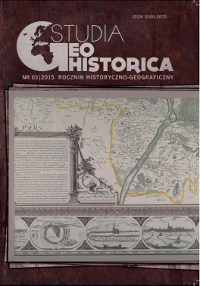Młyny wodne w ziemiach świeckiej i nowskiej do końca XVI wieku
Water Mills in Świecie and Nowe Lands till the End of the 16th Century
Author(s): Rafał KubickiSubject(s): Historical Geography, Economic history
Published by: Polskie Towarzystwo Historyczne
Keywords: ziemia świecka i ziemia nowska;Prusy Królewskie;średniowiecze;okres wczesnonowożytny;gospodarka;młyny wodne;osadnictwo XV w.;geografia historyczna;Royal Prussia;Middle Ages early modern period;economy
Summary/Abstract: The article investigates the issue of the development of a network of water mills in Świecie and Nowe Lands, the borders of which were approximately similar to the Świecie and Nowe castellanies existing in the 13th c. After the territory of Gdańsk Pomerania was taken over by the Teutonic Order in 1308–1309, the newly established Teutonic administration units existed here: the Świecie Commandry and the Nowe District of the Tczew Aldermanship, which after the year 1466 were transformed into the Świecie and Nowe Starosty Districts. Due to the investment costs and the legal restrictions, water mills were built the fastest as part of large landed properties organised by local dukes and church institutions (Włocławek bishops, the Cistercians of Oliwa and Pelplin and the Norbertines of Żukowo). After the year 1309, the Teutonic Order, building its administration here, aimed at introducing the legal solutions which it had developed and applied in the territory of Prussia proper. They consisted in almost full legal control in this respect. Th e right to build mills was classified as regalia, i.e. exclusive authorisations which it granted to other entities, usually by conferring in exchange for rent. During the Middle Ages, in Świecie and Nowe Lands, a relatively dense network of water mills, both in church villages and state villages (then Teutonic, and later royal) was built. They were also present in the knights’ estates, but they appeared there on a larger scale only at the end of the 15th and 16th c. Th e factor which influenced the formation of the water mill network, except the obvious relation to the development of agriculture, was the law – the mill regalia executed by the Teutonic Order. A significant change in that respect occurred after the year 1466, when the formerly existing restrictions on erecting mills in private estates disappeared.
Journal: Studia Geohistorica
- Issue Year: 2015
- Issue No: 3
- Page Range: 74-88
- Page Count: 15
- Language: Polish

